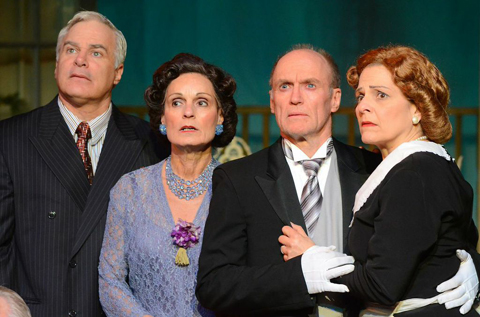
WHODUNIT? Sullivan, Faber, Cotter, and Carpentier. [Photo by Richard W. Dionne, Jr.] |
Today the 66 detective novels of English writer Agatha Christie may seem as quaint as Angela Lansbury’s Murder, She Wrote. Nevertheless, she remains the best-selling novelist in history, only the Bible and Shakespeare are more widely published. Her mystery play The Mousetrap still holds the record for filling seats, and her best best-selling novel, And Then There Were None, has sold more than 100 million copies. So no wonder 2nd Story Theatre is staging Christie’s fast-paced adaptation of that classic mystery (through August 31), in a production as snappy in previews as in its regular run, directed by Ed Shea.
Christie’s popularity was assured by her clever unpredictability with a predictable genre. In Murder On the Orient Express, all of the suspects turn out to have participated in the murder; in The Murder of Roger Ackroyd, we find that the culprit is the narrator. She certainly keeps people guessing.
And Then There Were None has one of those familiar structures in which a number of people are confined in a room and have to figure out if the killer is among them. In this version, it’s not just a room but an island — on various pretexts, 10 people have been lured to an isolated mansion off the Devonshire coast, and one by one they start being eliminated, just like in the nursery rhyme “Ten Little Indians,” a variation of which the characters here recite. It starts out: “Ten little soldier boys went out to dine/One choked his little self, and then there were nine ...” and concludes with “And then there were none.” (Dismaying historical note: the original British title used the N-word.)
Anyone who has read the novel should be prepared for a rather radical change in this adaptation: despite the title, and to induce smiles rather than tears at the final curtain, Christie decided that not everybody should die this time. Bummer plots don’t fill seats.
Everyone gathers together on their arrival, their hosts ostensibly planning to meet them the following day, until which time they will be taken care of by a butler and cook, Mr. and Mrs. Rogers (Walter Cotter, Sharon Carpentier). The entire dozen of them soon are accused of having gotten away with murder on various occasions. This is established toward the beginning when the butler, following written instructions, puts on a phonograph record, but instead of music out comes a voice detailing each of their crimes. As each is knocked off, another tiny soldier in a row of statuettes is noticed missing.
The first victim is the person we least care about, the obnoxious blowhard Mr. Marston (Charles Lafond), succumbing to cyanide in the drink that made it easier for him to put his moves on the most sympathetic character, Miss Claythorne (Erin Elliott). A secretary hired for the event, the young woman had been a governess, but in complicity with her lover had allowed a boy in her charge to drown.